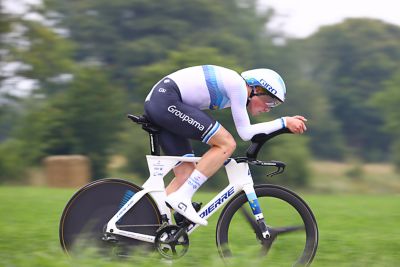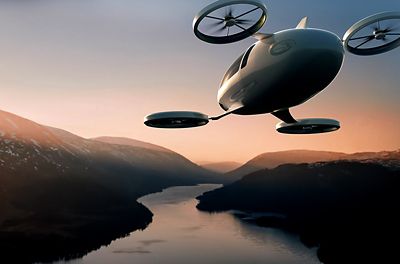-
United States -
United Kingdom -
India -
France -
Deutschland -
Italia -
日本 -
대한민국 -
中国 -
台灣
-
Ansysは、今日の学生が成功を収めるために、シミュレーションエンジニアリングソフトウェアを学生に無料で提供することを約束します。
-
Ansysは、今日の学生が成功を収めるために、シミュレーションエンジニアリングソフトウェアを学生に無料で提供することを約束します。
-
Ansysは、今日の学生が成功を収めるために、シミュレーションエンジニアリングソフトウェアを学生に無料で提供することを約束します。
ANSYS ADVANTAGE MAGAZINE
October 2021
In the hyper-competitive world of professional cycling, the slimmest of margins — a mere matter of seconds — can be the difference between winning and winding up out of medal contention. Getting to the finish line at all often comes down to being a fraction of a second faster during individual time trials than hundreds of other competitors.
It’s no wonder then that road cycling teams are looking for any ethical way possible to shave even milliseconds off of their performance. For France’s Equipe Cycliste Groupama-FDJ, their plans to outpace the competition are riding in part on aerodynamic simulation.
Led by physiologist and Director of Performance Dr. Fred Grappe — an expert on aerodynamics in cycling and author of important research on improving training and performance capacity through science — Groupama-FDJ set out in 2019 to design what they believe will prove to be the fastest racing bicycle ever, the Aerostorm DRS. Working with partners Lapierre Bikes and professor Bert Blocken, scientific director of the University of Eindhoven wind tunnel and Professor at Technology University of Eindhoven and KU Leuven, their efforts included airflow modeling using Ansys Fluent to understand the aerodynamics of the bicycle’s lightweight carbon frame tubes. Simulation helped designers streamline the frame to reduce drag. The speed-slowing, aerodynamic force that the cyclist needs to counter to move faster, drag can keep even the best trained athlete from the podium.

Stefan Kung, photo credit: Presse Sports
Less Drag, Faster Finishes
Eighty percent of the drag on a bicycle comes from the human body. Because it is not possible to change the shape of an athlete, at best we can optimize his or her position. However, we can modify the shape of the bicycle to reduce drag. Small gains can make big differences.
通过par的休闲自行车骑手骑k, drag might not be terribly meaningful, but the faster someone cycles, the more pronounced the effect becomes. Countering drag at world-class cycling speeds requires tremendous stamina and exertion. It’s generally thought that a cyclist pedaling 48 km per hour (29.8 mph, which is slower than the typical Tour de France effort) will spend 90% of his or her power just trying to overcome aerodynamic drag.
虽然比掉自行车可以减少阻力er, even incremental reductions in drag can make a significant difference in how much energy the athlete has to expend over the entire racecourse. Better aerodynamics mean the cyclist can conserve energy throughout the race for a bigger kick at a crucial moment.
For Groupama-FDJ and Lapierre, usingFluentto quantify the drag originating from every component of the Aerostorm DRS frame allowed them to modify the geometry of the bike’s components and optimize the shape of certain frame tubes. Those modifications led to a nearly 7% drag reduction compared to previous bikes.
Modifying Frame Tubes to Reduce Drag
Frame tubes — the components that comprise the frame of a racing bike — can essentially be thought of as cylinders. This sounds fairly unimportant until you consider that airflows around cylinders are extremely complicated: they’re unstable, somewhat counterintuitive and can redirect airflow to unexpected parts of the bike or the athlete. Add in the fact that bicycle frame components negatively affect the aerodynamics of one another— a problem that’s especially noticeable on the diagonal downtube — and it makes studying aerodynamic phenomena even more challenging. To properly capture these complex flow patterns, the quality of the mesh is essential; the thickness of the cells close to the tube is much smaller than a mm. Furthermore, high-resolution CFD simulations are performed with the 3D Reynolds averaged Navier-Stokes (RANS) equations and the Transition SST k-w model; these computer models have been validated by numerous wind tunnel tests.
通过模拟每一帧管流利的,航空storm DRS design team was able to overcome those obstacles. Modeling the laminar, transitional and turbulent airflows around the components at speeds from about 32 km per hour to 99 km per hour (20 mph to 62 mph) helped them to understand airflow resistance and circulation, and to quantify drag on different places on the bike. Indeed, it is essential to focus on the parts of the bike that contribute the most to the global drag to maximize the gain; on the other end, local improvements of the aerodynamics of some components may have negative effect on the global drag because they are modifying the airflow driving more air to drag generator sections. It is essential to find the right compromise between components optimization and global drag reduction — what only simulation can do in a cost- and time-effective way. That could never be accomplished in the wind tunnel or the velodrome.
Winning a Close Game
That’s not to suggest that simulation is now the only tool in the bike designer’s kit. Simulation hasn’t replaced wind tunnel or ground testing, but works hand in hand with them. It allows faster and more confident prototyping and less of the trial-and-error that went into creating new products the “old” way. Still, a prototype of every Lapierre Bikes model is road-tested by a professional cyclist whose feedback goes into the next iteration.
In fact, when it comes to using modeling, the Groupama-FDJ team’s status of being early adopters makes them somewhat of an outlier in their sport. Motor sports, including Formula One, have embraced simulation, and America’s Cup racers are using it as well. But the cycling world has been slower to catch onto its benefits. That could change, however, once Aerostorm DRS riders start finishing in the top spots. After all, bicycle racing is a close game, with cyclists looking for every second they can find on the road. If simulation can help uncover a second here and a second there, it’s likely to be seen as essential to bike design and, eventually, racing success.
Ansysができること
Ansysができること
お問い合わせ
お問い合わせいただき、ありがとうございます。
We’re here to answer your questions and look forward to speaking with you. A member of our Ansys sales team will contact you shortly.













